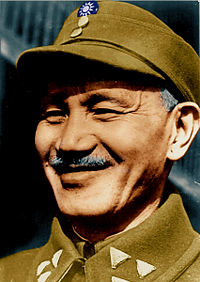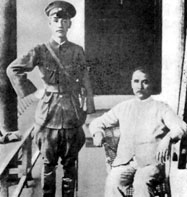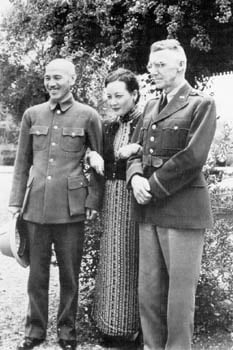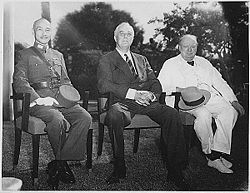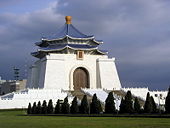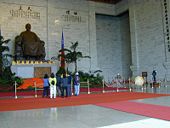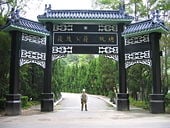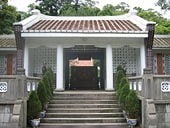Chiang Kai-shek
Chiang Kai-shek (October 31, 1887 – April 5, 1975) was one of the most important political leaders in twentieth century Chinese history, serving between Sun Yat-sen and Mao Zedong. He was a military and political leader who assumed the leadership of the Kuomintang (KMT) after the death of Sun Yat-sen in 1925. He commanded the Northern Expedition to unify China against the warlords and emerged victorious in 1928, as the overall leader of the Republic of China (ROC). Chiang led China in the Second Sino-Japanese War, during which time his international prominence grew.
During the Chinese Civil War (1926–1949), Chiang attempted to eradicate the Chinese Communists but ultimately failed, forcing his government to retreat to Taiwan (The Republic of China) where he continued serving as the President of the Republic and Director-General of the KMT for the remainder of his life. Taiwan occupied China's Permanent Seat in the United Nations Security Council until 1971, when UN Resolution 2758 was adopted. This resolution recognized for the first time the Government of the People's Republic of China (Mainland China) as the legitimate representatives of China to the United Nations. With this resolution, the representatives of Chiang Kai-shek's government-in-exile were expelled from the UN.
Chiang, a fervent patriot, had the adaptability to switch from political to military leader and back again. His original goal was the modernization of China, yet the constancy of war during his tenure dictated his effectiveness.
Chiang Kai-shek's legacy was incomplete. Though he was personally ascetic, corruption flourished in the KMT under him. Favored by Western democracies, in contrast he imposed martial law on Taiwan. He attempted to unify his divided nation, and to stabilize and develop it as well. Though he failed in a number of respects, he left behind a prosperous economy that grew into a genuine democracy. Chiang is known for his vigorous anti-communist stance, having founded the World Anti-Communist League (WACL). Across the Taiwan Straits on the mainland, more than one million Chinese were murdered during the first cultural revolution of 1949, and some estimates place the number as more than 27,000,000 deaths from starvation in the famine which lasted from from 1959 through 1961. The second Cultural Revolution, equally devastating to human freedom of expression, began in 1966 and ended in 1976, soon after Mao's death. It was this needless suffering and loss of life under communism that motivated Chiang to fight it throughout his adult life.
Personal life
On October 31, 1887, Chiang Kai-shek was born in the town of Xikou, Fenghua County, Ningbo Prefecture, Zhejiang. However, his ancestral home, a concept important in Chinese society, was the town of Heqiao in Jiangsu Province, not far from the shores of the famous Lake Taihu.
His parents were Chiang Zhaocong and Wang Caiyu, part of an upper-middle class family of farmers and salt merchants.
Youth and education
Chiang attended private school, where he learned the Chinese classics. Both his father and his grandfather died while he was young. He is said to have adored his mother even more for that, describing her as the "embodiment of Confucian virtues."
At that time in Chinese society, fatherless families were looked down upon and often taken advantage of. Tolerant of the hardships they faced following his father's death, the young Chiang developed an enthusiasm for learning. He continued his classical studies until the age of 17, when he enrolled in a modern school. Following that, he attended school at Ningbo, where he studied current affairs and western law.
During this time his attentions turned to Sun Yat-sen, a revolutionary and political leader of the time (today known as the "father of modern China"). This interest eventually led him towards his path of leadership.
Chiang grew up in an era in which military defeats and civil wars among warlords had left China destabilized and in debt, and he decided to pursue a military career to save his country. He began his military education at the Baoding Military Academy in 1906. He began attending a preparatory school for Chinese students, Rikugun Shikan Gakko in Japan in 1907. There, he was influenced by his compatriots to support the revolutionary movement to overthrow the Qing Dynasty and to set up a Chinese Republic. He befriended fellow Zhejiang native Chen Qimei, and, in 1908, Chen brought Chiang into the Tongmenghui, a precursor organization of the Kuomintang. Chiang served in the Imperial Japanese Army from 1909 to 1911. In 1923, he was dispatched to Moscow to study military techniques, returning as the first commandant of the Whampoa Military Academy in 1924, an institution that provided the most talented generals of both the Kuomintang and the Communist armies.
Early marriages
In a marriage arranged by their parents, Chiang was wed to fellow villager Mao Fumei (1882–1939). Chiang and Mao had a son Chiang Ching-Kuo and a daughter Chien-hua. Mao died in the Second Sino-Japanese War during a bombardment.
While married to Mao, Chiang adopted two concubines:
- He married Yao Yecheng (1889-1972) in 1912. Yao raised the adopted Wei-kuo. She fled to Taiwan and died in Taipei.
- He married Chen Jieru (1906-1971) in December 1921. Chen had a daughter in 1924, named Yaoguang, who later adopted her mother's surname. Chen's autobiography disclaims the idea that she was a concubine, claiming that by the time she married Chiang, he had already been divorced from Mao, making her his wife. Chen lived in Shanghai. She later moved to Hong Kong, where she lived until her death.
Madame Chiang Kai-shek (Mayling Soong)
In 1920, Chiang met Mayling Soong, who was American-educated and a devout Christian. A Buddhist, Chiang was eleven years her elder. Married, Chiang nonetheless proposed marriage to Mayling, much to her mother's objections. Determined to make Mayling his wife, he eventually provided proof of divorce and made a committed conversion to Christianity. He was baptized in 1929.
Madame Chiang Kai-shek was a crucial partner to her husband in his public affairs, acting as his English translator, secretary, adviser and an influential propagandist for the cause of nationalism. Understanding the Western mind and being a skilled negotiator, in February 1943, she became the first Chinese national, and the second woman, to ever address a joint session of the U.S. House and Senate, making the case for strong U.S. support of China in its war with Japan.
Following her husband's death in 1975, she returned to the United States, residing in Lattington, New York. Madame Chiang Kai-shek passed away on October 23, 2003, at the age of 105.
Public life
For several years, Chian Kai-shek traveled between Japan and China, furthering both his military and political training. When revolution in his homeland became evident in 1911, he returned to China where he devoted his life seeking to stabilize and develop the nation, though at times he did this from a point of exile.
Rise to power
With the outbreak of the Wuchang Uprising in 1911, Chiang Kai-shek returned to China to fight in the revolution as an artillery officer. He served in the revolutionary forces, leading a regiment in Shanghai under his friend and mentor Chen Qimei. The Xinhai Revolution was ultimately successful in overthrowing the Qing Dynasty and Chiang became a founding member of the Kuomintang.
After takeover of the Republican government by Yuan Shikai and the failed Second Revolution, Chiang, like his Kuomintang comrades, divided his time between exile in Japan and haven in Shanghai's foreign concession areas. In Shanghai, Chiang also cultivated ties with the criminal underworld dominated by the notorious Green Gang and its leader Du Yuesheng. In 1915, Chen Qimei, Sun Yat-sen's chief lieutenant, was assassinated by agents of Yuan Shikai and Chiang succeeded him as the leader of the Chinese Revolutionary Party in Shanghai.
In 1917, Sun Yat-sen moved his base of operations to Guangzhou and Chiang joined him the following year. Sun, who at the time was largely sidelined and without arms or money, was expelled from Guangzhou in 1918 and exiled again to Shanghai, but recovered with mercenary help in 1920. However, a rift had developed between Sun, who sought to militarily unify China under the KMT, and Guangdong Governor Chen Jiongming, who wanted to implement a federalist system with Guangdong as a model province.
On June 16, 1923, Chen attempted to expel Sun from Guangzhou and had his residence shelled. Sun and his wife Song Qingling narrowly escaped under heavy machine gun fire, only to be rescued by gunboats under the direction of Chiang Kai-shek. The incident earned Chiang Kai-shek Sun Yat-sen's lasting trust.
Sun regained control in Guangzhou in early 1924, with the help of mercenaries from Yunnan, and accepted aid from the Comintern. He then undertook a reform of the Kuomintang and established a revolutionary government aimed at unifying China under the KMT. That same year, Sun sent Chiang Kai-shek to Moscow to spend three months studying the Soviet political and military system. Chiang left his eldest son Ching-kuo in Russia, who would not return until 1937.
Chiang returned to Guangzhou and in 1924, was made Commandant of the Whampoa Military Academy. The early years at Whampoa allowed Chiang to cultivate a cadre of young officers loyal to him and by 1925, Chiang's proto-army was scoring victories against local rivals in Guangdong province. Here he also first met and worked with a young Zhou Enlai, who was selected to be Whampoa's Political Commissar. However, Chiang was deeply critical of the Kuomintang-Communist Party United Front, suspicious that the Communists would take over the KMT from within.
With Sun Yat-sen's death in 1925, a power vacuum developed in the KMT. A power struggle ensued between Chiang, who leaned towards the right wing of the KMT, and Sun Yat-sen's close comrade-in-arms Wang Jingwei, who leaned towards the left wing of the party. Though Chiang ranked relatively low in the civilian hierarchy, and Wang had succeeded Sun to power as Chairman of the National Government, Chiang's deft political maneuvering eventually allowed him to emerge victorious.
Chiang made gestures to cement himself as the successor of Sun Yat-sen. In a pairing of much political significance, on December 1, 1927, Chiang married Soong May-ling, the younger sister of Soong Ching-ling, Sun Yat-sen's widow, and thus positioned himself as Sun Yat-sen's brother-in-law. In Beijing, Chiang paid homage to Sun Yat-sen and had his body moved to the capital, Nanjing, to be enshrined in the grand mausoleum.
Chiang, who became Commander-in-Chief of the National Revolutionary Forces in 1925, launched in July 1926, the Northern Expedition, a military campaign to defeat the warlords controlling northern China and unify the country under the KMT. He led the victorious Nationalist army into Hankou, Shanghai, and Nanjing. After taking Nanjing in March (and with Shanghai under the control of his close ally General Bai), Chiang was forced to halt his campaign and decided first clean house and break with the leftists. This was the beginning of the long civil war between the Kuomintang and the Communists.
On April 12, 1927, Chiang began a swift attack on thousands of suspected Communists. He then established National Government in Nanking, supported by conservative allies (including Hu Hanmin). The communists were purged from the KMT and the Soviet advisers were expelled. Wang Jingwei's National Government was unpopular with the masses, and was weak militarily and was soon overtaken. Eventually Wang and his leftist party surrendered to Chiang and join him in Nanking.
Chiang's actions earned him the support and financial backing of the Shanghai business community, and maintained him the loyalty of his Whampoa officers, many of whom hailed from Hunan elites and were discontented by the land redistribution Wang Jingwei was enacting in the area.
Chiang established his own National Government in Nanjing, supported by his conservative allies. By the end of 1927, he controlled the Kuomintang, and in 1928, he became head of the Nationalist government at Nanjing and generalissimo of all Chinese Nationalist forces.
From that point on, he exercised virtually uninterrupted power as leader of the Nationalist government. The warlord capital of Beijing was taken in June 1928, and in December, the Manchurian warlord Chang Hsueh-liang pledged allegiance to Chiang's government.
Tutelage over China
Chiang Kai-shek gained nominal control of China, but his party was "too weak to lead and too strong to overthrow." In 1928, Chiang was named Generalissimo of all Chinese forces and Chairman of the National Government, a post he held until 1932 and later from 1943 until 1948. According to KMT political orthodoxy, this period thus began the period of "political tutelage" under the dictatorship of the Kuomintang.
The decade of 1928 to 1937, was one of consolidation and accomplishment for Chiang's government. Some of the harsh aspects of foreign concessions and privileges in China were moderated through diplomacy. The government acted energetically to modernize the legal and penal systems, stabilize prices, amortize debts, reform the banking and currency systems, build railroads and highways, improve public health facilities, legislate against narcotics-trafficking, and augment industrial and agricultural production. Great strides also were made in education and, in an effort to help unify Chinese society the New Life Movement was launched to stress Confucian moral values and personal discipline. Mandarin was promoted as a standard tongue. The widespread establishment of communications facilities further encouraged a sense of unity and pride among the people.
These successes, however, were met with constant upheavals with need of further political and military consolidation. Though much of the urban areas were now under the control of his party, the countryside still lay under the influence of severely weakened yet undefeated warlords and communists. Chiang fought with most of his warlord allies. One of these northern rebellions against the warlords Yen Hsi-shan and Feng Yuxiang in 1930 almost bankrupted the government and cost almost 250,000 casualties.
When Hu Han-min established a rival government in Guangzhou in 1931, Chiang's government was nearly toppled. A complete eradication of the Communist Party of China eluded Chiang. The Communists regrouped in Jiangxi and established the Chinese Soviet Republic. Chiang's anti-communist stance attracted the aid of Nazi Germany military advisers, and in Chiang's fifth campaign to defeat the Communists in 1934, he surrounded the Red Army only to see the Communists escape through the epic Long March to Yan'an.
Wartime leader of China
After Japan's invasion of Manchuria in 1931, Chiang temporarily resigned as Chairman of the National Government. Returning, he adopted a slogan "first internal pacification, then external resistance," which meant that the government would first attempt to defeat the Communists before engaging the Japanese directly. Though it continued for several years, the policy of appeasing Japan and avoiding war was widely unpopular. In December 1936, Chiang flew to Xi'an to coordinate a major assault on People's Liberation Army (Red Army) forces holed up in Yan'an. On December 12, Chang Hsueh-liang whose homeland of Manchuria had been invaded by the Japanese, and several other Nationalist generals, kidnapped Chiang Kai-shek for two weeks in what is known as the Xi'an Incident. The conditions for his release included his agreement to form a "United Front" against Japan. Chiang refused to make a formal public announcement of this "United Front" as many had hoped, and his troops continued fighting the Communists throughout the war.
All-out war with Japan broke out in July 1937. In August of the same year, Chiang sent 500,000 of his best trained and equipped soldiers to defend Shanghai. With about 250,000 Chinese casualties, Chiang lost his political base of Whampoa-trained officers. Although Chiang lost militarily, the battle dispelled Japanese claims that it could conquer China in three months and demonstrated to the Western powers (which occupied parts of the city and invested heavily in it) that the Chinese would not surrender under intense Japanese fire. This was skillful diplomatic maneuvering on the part of Chiang, who knew the city would eventually fall, but wanted to make a strong gesture in order to secure Western military aid for China. By December, the capital city of Nanjing had fallen to the Japanese and Chiang moved the government inland to Chongqing. Devoid of economic and industrial resources, Chiang could not counter-attack and held off the rest of the war preserving whatever territory he still controlled, though his strategy succeeded in stretching Japanese supply lines and bogging down Japanese soldiers in the vast Chinese interior who would otherwise have been sent to conquer southeast Asia and the Pacific islands.
With the Attack on Pearl Harbor and the opening of the Pacific War, China became one of the Allied Powers. During and after World War II, Chiang and his American-educated wife, Soong May-ling, "Madame Chiang Kai-shek," held the unwavering support of the United States China Lobby which saw in them the hope of a Christian and democratic China.
Chiang's strategy during the War opposed the strategies of both Mao Zedong and the United States. The U.S. regarded Chiang as an important ally able to help shorten the war by engaging the Japanese occupiers in China. Chiang, in contrast, used powerful associates such as H.H. Kung (1861-1967), the banker and politician, in Hong Kong, to build the Republic of China army for certain conflict with the communist forces after the end of World War II. This fact was not understood well in the United States. The U.S. liaison officer, General Joseph Stilwell, correctly deduced that Chiang's strategy was to accumulate munitions for future civil war rather than fight the Japanese, but Stilwell was unable to convince Franklin Delano Roosevelt of this and precious Lend-Lease armaments continued to be allocated to the Kuomintang. Chiang was recognized as one of the "Big Four" Allied leaders along with Roosevelt, Churchill, and Stalin and traveled to attend the Cairo Conference in November 1943. His wife acted as his translator and adviser.
Losing China
The Japanese surrender in 1945 did not bring peace to China, rather it allowed the Nationalists under Chiang Kai-shek and the Communists under Mao Zedong to resume their fight against each other. Chiang's Chonqing government was ill-equipped to reassert its authority in eastern China. It was able to reclaim the coastal cities with American assistance, and sometimes those of former puppet and Japanese troops, a deeply unpopular move. The countryside in the north was already largely under the control of the Communists, whose forces were better motivated and disciplined than those of the KMT.
The United States had encouraged peace talks between Chiang and Communist leader Mao Zedong, in Chongqing. Distrustful of each other and of the United States' professed neutrality, they soon resorted to all-out war. The U.S. suspended aid to Chiang Kai-shek for much of the period of 1946 to 1948, in the midst of fighting against the People's Liberation Army, led by Mao Zedong.
Though Chiang had achieved status abroad as a world leader, his government was deteriorating with corruption and inflation. The war had severely weakened the Nationalists both in terms of resources and popularity while the Communists were strengthened by aid from Stalin and guerrilla organizations extending throughout rural areas. At the same time, with the influx of Western money and military aid, Chiang's high-level Kuomintang officers began to grow complacent and corrupt. Seeking to increase his party's strenght, Chiang increased ties to his country's wealthy landlords. This resulted in the alienation of the peasant population, which represented more than 90 percent of Chinese inhabitants. By the end of World War II, the communists had become formidable rivals, due to their large numbers and the strength of their seemingly logical ideology.
Meanwhile a new Constitution promulgated in 1947, and Chiang was elected by the National Assembly to be President. This marked the beginning of the democratic constitutional government period in KMT political orthodoxy, but the Communists refused to recognize the new Constitution and its government as legitimate.
Chiang resigned as President on January 21, 1949, as KMT forces suffered massive losses against the communists. Vice President Li Tsung-jen took over as Acting President, but his relationship with Chiang soon deteriorated, as Chiang continued to act as if he were in power, and Li was forced into exile in the United States. Under Chiang's direction, Li was later formally impeached by the Control Yuan.
After four years of civil war, Chiang and the nationalists were forced to flee mainland China in the early morning hours of December 10, 1949, when Communist troops laid siege to Chengdu, the last KMT occupied city in mainland China, where Chiang Kai-shek and his son Chiang Ching-kuo directed the defense at the Chengdu Central Military Academy.
They were evacuated to Taiwan, where they established a government-in-exile and dreamed of retaking the mainland, never foreseeing that it was to be their last time on their home soil.
Presidency in Taiwan
By 1950, Chiang Kai-shek and the Nationalist government had been driven from the mainland to the island of Taiwan (Formosa) and U.S. aid had been cut off. He was elected by the National Assembly to be the President of the Republic of China on March 1, 1950. In this position he continued to claim sovereignty over all of China and until his death in 1975, he ruled "Nationalist China," developing it into an Asian economic power.
In the context of the Cold War, most of the Western world recognized this position and the ROC represented China in the United Nations and other international organizations until the 1970s.
On Taiwan, Chiang took firm command and established a virtual dictatorship. Despite the democratic constitution, the government under Chiang was a politically repressive and authoritarian single-party state, consisting almost completely of non-Taiwanese mainlanders; the "Temporary Provisions Effective During the Period of Communist Rebellion" greatly enhanced executive power and the goal of "retaking the mainland" allowed the KMT to maintain its monopoly on power and to outlaw opposition parties.
Chiang's government sought to impose Chinese nationalism and repressed the local culture, such as by forbidding the use of the Taiwanese language in mass media broadcasts or in schools. The government permitted free debate within the confines of the legislature, but jailed dissidents who were either labeled as supporters of the Chinese Communist Party or of Taiwan independence.
He reorganized his military forces with the help of U.S. aid, which had resumed with the start of the Korean war, and then instituted limited democratic political reforms. He continually promised reconquest of the mainland and periodically landed Nationalist guerrillas on the China coast, embarrassing the United States in doing so. Though he was one of the few leaders to send forces to Vietnam to support the U.S. war effort, he was never able to accomplish reunification in his own homeland. His international position was weakened considerably in 1971, when the United Nations expelled his regime and accepted the Communists as the sole legitimate government of China.
Since new elections could not be held in their Communist-occupied constituencies, the members of the KMT-dominated National Assembly held their posts indefinitely. It was under the Temporary Provisions that Chiang was able to bypass term limits to remain as president. He was reelected, unopposed, by the National Assembly as president four times in 1954, 1960, 1966, and 1972.
Defeated by the Communists, Chiang purged members of the KMT previously accused of corruption, and major figures in the previous mainland government such as H.H. Kung and T.V. Soong (1894-1971) exiled themselves to the United States. Though the government was politically authoritarian and controlled key industries, it encouraged economic development, especially in the export sector. A sweeping Land Reform Act, as well as American foreign aid during the 1950's laid the foundation for Taiwan's economic success, becoming one of the "East Asian Tigers."
In 1971, the United Nations passed Resolution 2758 which restored the rights of the People's Republic of China and recognized it as the only lawful representative of China to the United Nations. With Mainland China's entry into the UN, Taiwan lost its seat and representation. Since that time, Taiwan has sought, to no avail, a permanent seat, citing the UN's founding on the principles of universality and self-determination.[1]
Death and legacy
On April 5, 1975, 26 years after Chiang Kai-shek fled to Taiwan, he died in Taipei at the age of 87. He had suffered a major heart attack and pneumonia in the months before, and died from renal failure aggravated by advanced cardiac malfunction.
A month of mourning was declared during which the Taiwanese people wore black armbands. Televisions ran in black-and-white while all banquets or celebrations were forbidden. On the mainland, however, Chiang's death was met with little apparent mourning and newspapers gave the brief headline "Chiang Kai-shek Has Died."
Chiang's corpse was put in a copper coffin and temporarily interred at his favorite residence in Cihhu, Dasi, Taoyuan County. When his son Chiang Ching-kuo died in 1988, he was also entombed in a separate mausoleum in nearby Touliao. The hope was to have both buried at their birthplace in Fenghua once the mainland was recovered. In 2004, Chiang Fang-liang, the widow of Chiang Ching-kuo, asked that both father and son be buried at Wuchih Mountain Military Cemetery in Sijhih, Taipei County. Chiang Fang-liang and Soong May-ling had agreed, in 1997, that the former leaders be first buried but still be moved to mainland China in the event of reunification.
Chiang's popularity in Taiwan is sharply divided among political lines, enjoying greater support among KMT voters and the mainlander population. However, he is largely unpopular among DPP supporters and voters. Since the democratization of the 1990s, his picture began to be removed from public buildings and Taiwanese currency, while many of his statues have been taken down; in sharp contrast to his son Ching-kuo and to Sun Yat-sen, his memory is rarely invoked by current political parties, including the Kuomintang.
Chiang Kai-shek is well-remembered as the leader of the anti-Communists and invested many years of his life in the pursuit of its overthrow. However, what he had initially pursued was the modernization of China. He thus joined the revolutionary group of Sun Yat-sen, which believed the modernization of China could not be accomplished under the Qing regime.
Fearing that China would become a colony of a foreign power, Chiang helped establish the Kuomintang, which aimed at preparing the modern army to unite China and overthrow the warlords. This had a great impact on his nation, establishing organizations in businesses and schools. Such was the impact of Chiang's revolutionary theory on the Chinese population. The Kuomintang brought about the end of imperialism, overthrew the warlords, and targeted corruption of officers as the mainframe of his inner policy.
Chiang's ideals and goals included, as he frequently referred to, were; "establishment of a government of integrity," "organization of the people's army," and "indemnify the rights of agricultural and industrial organizations." Unfortunately such goals were not realized and corruption seeped into the party.
Chiang Kai-shek, though his ideals ultimately failed, was a man of noble ideals who loved his people and lived his life seeking for a better homeland for them.
Notes
- ↑ New Tawain, What does Resolution 2758 say? Retrieved January 28, 2008.
ReferencesISBN links support NWE through referral fees
- The Columbia Encyclopedia, Sixth Edition. Chiang Kai-shek. Retrieved January 28, 2008.
- Crozier, Brian. The Man Who Lost China. New York: Scribner, 1976. ISBN 068414686X.
- Discovering China. Movers & Shakers: Chiang Kaishek (1887-1975). Retrieved January 28, 2008.
- Fenby, Jonathan. Generalissimo Chiang Kai-Shek and the China he Lost. New York: The Free Press, 2003. ISBN 0743231449.
- New Taiwan. What does Resolution 2758 say? Retrieved January 28, 2008.
- Reese, Lori. China's Christian Warrior. Time Inc. Retrieved January 28, 2008.
- Seagrave, Sterling. The Soong Dynasty. New York: Harper & Row, 1985. ISBN 0060153083.
- Who2, LLC. Chiang Kai-shek. Retrieved January 28, 2008.
- Wolf, Mur. Madame Chiang Kai-shek. Wellesley College. Retrieved January 28, 2008.
External links
All links retrieved December 9, 2023.
- Order of Generalissimo Chiang Kai-shek supplementing the Act of Surrender by Japan on September 9 1945
Credits
New World Encyclopedia writers and editors rewrote and completed the Wikipedia article in accordance with New World Encyclopedia standards. This article abides by terms of the Creative Commons CC-by-sa 3.0 License (CC-by-sa), which may be used and disseminated with proper attribution. Credit is due under the terms of this license that can reference both the New World Encyclopedia contributors and the selfless volunteer contributors of the Wikimedia Foundation. To cite this article click here for a list of acceptable citing formats.The history of earlier contributions by wikipedians is accessible to researchers here:
The history of this article since it was imported to New World Encyclopedia:
Note: Some restrictions may apply to use of individual images which are separately licensed.
